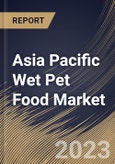Due to growing consumer awareness of its numerous benefits, wet food demand has increased steadily over time. One of the most crucial duties for pet owners today is to feed their animals nutritious, high-quality food. This is what inspires people to experiment with a variety of pet food options, from dry to chewable to wet food. There are many benefits to wet pet food over dry pet food, including greater variety, higher water content, fewer carbohydrates, and softness. For pets who are overweight or have dental issues or health issues that make it difficult for them to chew hard kibble, wet food is the perfect food option.
Increased adoption of pets in high-income countries is one of the primary factors driving wet pet food sales. Due to the positive effects on one's health and mood from owning a dog or cat, more people today adopt a pet. Numerous studies have shown that pets can lessen depression, anxiety, and stress, ease loneliness, and promote play and exercise. As demand for such goods keeps rising, a number of businesses are shifting their priorities towards the pet food industry. Wet food is frequently chosen for its texture and flavor by pet owners because it is convenient, nourishing, and palatable alternatives for their pets.
Urbanization and changing lifestyles in many Asian countries have led to smaller households and busier schedules. In response, pet ownership is on the rise as pets offer companionship in urban environments. Wet pet food is favored for its convenience, suitability for small living spaces, and ease of feeding, making it an appealing choice for urban pet owners. Additionally, as economies in the Asia Pacific region continue to grow, disposable incomes are on the rise. With increased financial stability, more households have the means to invest in premium pet food products, including wet pet food. The ability to afford higher-quality pet food options fuels market growth. Thus, the growth of the market in the Asia Pacific region is underpinned by rising disposable incomes, urbanization, increasing pet ownership, specialized formulations, diverse protein sources, cultural preferences, and an evolving regulatory environment.
The China market dominated the Asia Pacific Wet Pet Food Market by Country in 2022, and would continue to be a dominant market till 2030; thereby, achieving a market value of $2,679.8 Million by 2030. The Japan market is registering a CAGR of 4.9% during (2023 - 2030). Additionally, The India market would experience a CAGR of 6.3% during (2023 - 2030).
Based on Pet, the market is segmented into Dog, and Cat. Based on Source, the market is segmented into Animal-based, Plant-derivatives, and Synthetic. Based on Distribution Channel, the market is segmented into Pet Specialty Stores, Supermarkets/Hypermarkets, Convenience Stores, and Online. Based on countries, the market is segmented into China, Japan, India, South Korea, Singapore, Malaysia, and Rest of Asia Pacific.
The market research report covers the analysis of key stakeholders of the market. Key companies profiled in the report include Nestle S.A, Mars, Inc., Unicharm Corporation (DSG International (Thailand) PLC), Thai Union Group PLC, Charoen Pokphand Foods Public Company Limited, General Mills, Inc., The J.M Smucker Company, Schell & Kampeter, Inc., Farmina Pet Foods Holding B.V., The Colgate-Palmolive Company.
Scope of the Study
Market Segments Covered in the Report:
By Pet (Volume, Kilo Tonnes, USD Million/Billion, 2019-2030)- Dog
- Cat
- Animal-based
- Plant-derivatives
- Synthetic
- Pet Specialty Stores
- Supermarkets/Hypermarkets
- Convenience Stores
- Online
- China
- Japan
- India
- South Korea
- Singapore
- Malaysia
- Rest of Asia Pacific
Key Market Players
List of Companies Profiled in the Report:
- Nestle S.A
- Mars, Inc.
- Unicharm Corporation (DSG International (Thailand) PLC)
- Thai Union Group PLC
- Charoen Pokphand Foods Public Company Limited
- General Mills, Inc.
- The J.M Smucker Company
- Schell & Kampeter, Inc.
- Farmina Pet Foods Holding B.V.
- The Colgate-Palmolive Company
Unique Offerings
- Exhaustive coverage
- The highest number of Market tables and figures
- Subscription-based model available
- Guaranteed best price
- Assured post sales research support with 10% customization free
Table of Contents
Companies Mentioned
- Nestle S.A
- Mars, Inc.
- Unicharm Corporation (DSG International (Thailand) PLC)
- Thai Union Group PLC
- Charoen Pokphand Foods Public Company Limited
- General Mills, Inc.
- The J.M Smucker Company
- Schell & Kampeter, Inc.
- Farmina Pet Foods Holding B.V.
- The Colgate-Palmolive Company
Methodology

LOADING...








